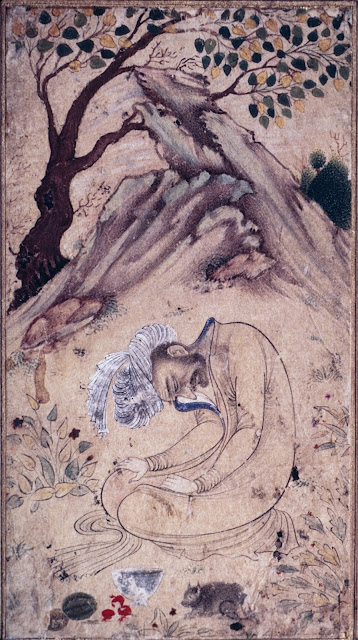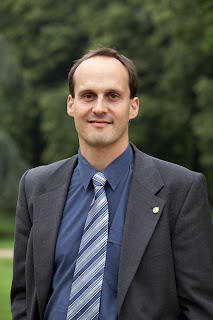Ecstasy, awe, peace, the experience of the insight that "all is One", a sense of being "outside of time",
the feeling that you experienced something sacred and holy, a gain of
insightful knowledge experienced at an intuitive level…Trippy, right?
Well, these are all elements from the Revised 30-item Mystical
Experience Questionnaire [1] that is based on the seven dimensions of
mystical experience, described by the British philosopher Walter Stace
in 1960 [2]. This questionnaire has been used in the study of mystical
experiences elicited by psychotropic drugs, like psilocybin and LSD (see
article on page 6).
Ceremonial use of hallucinogenic drugs dates back many thousands of years and is still part of many indigenous cultures of America (see also page 7). Although the reasons for using these substances in the ceremonies are varied, the goal is usually to facilitate the occurrence of a spiritual experience. Mystical or spiritual experiences occur also in the absence of drugs and have been reported inside and outside religious contexts. Meditation practices (page 5), for example, can lead to the experience of unity or pure awareness. For that reason, psychotropic drugs and meditative states have been used as models to study the neural correlates of mystical experience.
What Is the Default Mode Network?
Changes in the activity and connectivity of the default mode network (DMN) have been identified in studies where psychotropic drugs were used to elicit mystical experiences. This same network also shows changes during different meditation practices [3]. The default network is pretty much like the screen-saver of your brain. It is the network that gets active when you are not engaging in any activity that requires external focus, but rather just resting and letting your mind wander. The main components of the DMN are the medial prefrontal cortex (mPFC), the posterior cingulate cortex (PCC), the parahippocampal cortex (PHC) and the inferior parietal lobule (IPL) [4]. All these areas have a high density of serotonin 5-HT receptors, which are the targets of psychotropic drugs.
On Cloud Nine?
It is always exciting when common neural correlates can be found for such a broad and subjective human phenomenon like the spiritual experience. However, the mystery of mystical experiences still remains. It is interesting, for example, that these transient experiences of ego dissolution come with long- (often life-long) lasting feelings of insight and positive behavioral changes. How can a momentary detachment from our persistent self-awareness give us the feeling of an encounter with an ultimate truth?
Interestingly, the salvation or liberation
from the self is a recurrent idea in many religions. To become part of
the Absolute, reach Nirvana or be in God’s glory is the ultimate goal of
the major religions of the world. Religious/spiritual practices aim to
achieve this state through self-transformation and self-renunciation.
Certain attitudes like the distancing from practical life and detachment
from one’s and others’ needs and affections can facilitate the
emergence of spiritual experiences [8]. What about you? Have you been
close to a mystical experience?
[1] Barrett et al, J Psychopharmacol, 2015
[2] Stace, McMillan Press NY, 1960
[3] Barrett and Griffiths, Curr Topics Behav Neurosci, 2017
[4] Fox et al, PNAS, 2005
[5] Ranganath and Ritchey, Nat Rev Neurosci, 2012
[6] Shilbach et al, Conscious Cogn, 2008
[7] Battelli et al, Trends Cogn Sci, 2007
[8] Steinbock, Indiana University Press, 2007
by Silvina Romero Suárez, PhD Student AG Infante
 |
| A Sufi in Ecstasy in a Landscap, source: Wikimedia Commons |
Ceremonial use of hallucinogenic drugs dates back many thousands of years and is still part of many indigenous cultures of America (see also page 7). Although the reasons for using these substances in the ceremonies are varied, the goal is usually to facilitate the occurrence of a spiritual experience. Mystical or spiritual experiences occur also in the absence of drugs and have been reported inside and outside religious contexts. Meditation practices (page 5), for example, can lead to the experience of unity or pure awareness. For that reason, psychotropic drugs and meditative states have been used as models to study the neural correlates of mystical experience.
What Is the Default Mode Network?
Changes in the activity and connectivity of the default mode network (DMN) have been identified in studies where psychotropic drugs were used to elicit mystical experiences. This same network also shows changes during different meditation practices [3]. The default network is pretty much like the screen-saver of your brain. It is the network that gets active when you are not engaging in any activity that requires external focus, but rather just resting and letting your mind wander. The main components of the DMN are the medial prefrontal cortex (mPFC), the posterior cingulate cortex (PCC), the parahippocampal cortex (PHC) and the inferior parietal lobule (IPL) [4]. All these areas have a high density of serotonin 5-HT receptors, which are the targets of psychotropic drugs.
What is interesting about this network is that it appears to be involved in the perception of self. Since it integrates information from different areas of the brain, it appears to be giving a constant update on self-awareness. The PHC, for example, stores episodic memory [5], while the mPFC and PCC overlap with social cognition and self-referential areas of the brain [6]. These areas are active when you are entertained in your own internal dialog, thinking about yourself or other people’s thoughts and intentions. The IPL, on the other hand, has been implicated in the processing of time perception [7]. Brain imaging studies using psilocybin, LSD or mescaline, as well as studies that looked at the brain of experienced meditators, found both a decreased activity and decreased connectivity of the DMN. Therefore, it is hypothesized that a decrease in the connectivity of the IPL with the rest of the DMN mediate the feeling of timelessness and spacelessness, while the decreased connectivity in the PCC and mPFC mediate the feelings of unity and ego dissolution [3].How attached are you to your ego?
On Cloud Nine?
It is always exciting when common neural correlates can be found for such a broad and subjective human phenomenon like the spiritual experience. However, the mystery of mystical experiences still remains. It is interesting, for example, that these transient experiences of ego dissolution come with long- (often life-long) lasting feelings of insight and positive behavioral changes. How can a momentary detachment from our persistent self-awareness give us the feeling of an encounter with an ultimate truth?
 |
| Spiritual Yoga, source: pixabay |
[1] Barrett et al, J Psychopharmacol, 2015
[2] Stace, McMillan Press NY, 1960
[3] Barrett and Griffiths, Curr Topics Behav Neurosci, 2017
[4] Fox et al, PNAS, 2005
[5] Ranganath and Ritchey, Nat Rev Neurosci, 2012
[6] Shilbach et al, Conscious Cogn, 2008
[7] Battelli et al, Trends Cogn Sci, 2007
[8] Steinbock, Indiana University Press, 2007
by Silvina Romero Suárez, PhD Student AG Infante
This article originally appeared September 2017 in CNS Volume 10, Issue 3, Spirituality in Science





